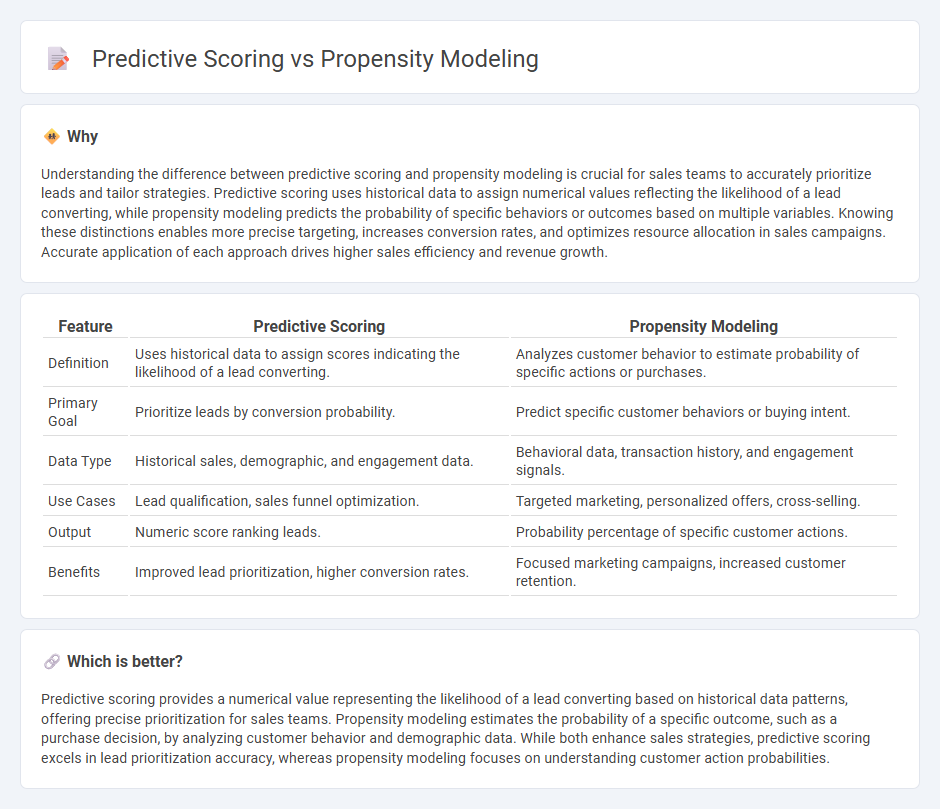
Predictive scoring leverages historical data and machine learning algorithms to assign numerical scores that indicate the likelihood of a prospect converting into a customer. Propensity modeling focuses on identifying specific behaviors and characteristics that increase the probability of a sale, enabling targeted marketing efforts. Explore how integrating predictive scoring and propensity modeling can transform your sales strategy for higher conversion rates.
Why it is important
Understanding the difference between predictive scoring and propensity modeling is crucial for sales teams to accurately prioritize leads and tailor strategies. Predictive scoring uses historical data to assign numerical values reflecting the likelihood of a lead converting, while propensity modeling predicts the probability of specific behaviors or outcomes based on multiple variables. Knowing these distinctions enables more precise targeting, increases conversion rates, and optimizes resource allocation in sales campaigns. Accurate application of each approach drives higher sales efficiency and revenue growth.
Comparison Table
| Feature | Predictive Scoring | Propensity Modeling |
|---|---|---|
| Definition | Uses historical data to assign scores indicating the likelihood of a lead converting. | Analyzes customer behavior to estimate probability of specific actions or purchases. |
| Primary Goal | Prioritize leads by conversion probability. | Predict specific customer behaviors or buying intent. |
| Data Type | Historical sales, demographic, and engagement data. | Behavioral data, transaction history, and engagement signals. |
| Use Cases | Lead qualification, sales funnel optimization. | Targeted marketing, personalized offers, cross-selling. |
| Output | Numeric score ranking leads. | Probability percentage of specific customer actions. |
| Benefits | Improved lead prioritization, higher conversion rates. | Focused marketing campaigns, increased customer retention. |
Which is better?
Predictive scoring provides a numerical value representing the likelihood of a lead converting based on historical data patterns, offering precise prioritization for sales teams. Propensity modeling estimates the probability of a specific outcome, such as a purchase decision, by analyzing customer behavior and demographic data. While both enhance sales strategies, predictive scoring excels in lead prioritization accuracy, whereas propensity modeling focuses on understanding customer action probabilities.
Connection
Predictive scoring and propensity modeling are interconnected techniques used to identify potential customers most likely to purchase a product or service. Predictive scoring assigns numerical values based on historical data patterns, while propensity modeling estimates the likelihood of future behavior by analyzing variables such as demographics, past purchases, and engagement metrics. Leveraging both methods enables sales teams to prioritize leads, optimize resource allocation, and enhance conversion rates effectively.
Key Terms
**Propensity Modeling:**
Propensity modeling involves analyzing historical data to estimate the likelihood of a specific outcome, such as customer purchase behavior or churn risk, by identifying key predictive factors. This technique leverages machine learning algorithms and statistical methods to generate precise probability scores that help businesses tailor marketing strategies and improve decision-making. Explore in-depth how propensity modeling drives personalized customer engagement and boosts conversion rates.
Likelihood to Buy
Propensity modeling estimates the probability that a customer will take a specific action, such as making a purchase, by analyzing historical behavior and demographic data. Predictive scoring assigns numerical values to individuals based on their likelihood to buy, enabling targeted marketing and resource allocation. Explore deeper insights into propensity modeling and predictive scoring to enhance customer acquisition strategies.
Behavioral Segmentation
Propensity modeling predicts the likelihood of a specific behavior by analyzing past actions and demographic data, making it a powerful tool for behavioral segmentation in marketing. Predictive scoring assigns scores to individuals based on their predicted future behaviors, enabling targeted campaigns tailored to distinct behavioral segments. Explore how combining these techniques can enhance your customer insights and drive more effective marketing strategies.
Source and External Links
An Introduction to Propensity Modeling - Propensity modeling utilizes statistical approaches to predict user actions based on past behavior and interactions.
Propensity Modelling: Definition, types and use cases - This blog explains the different techniques and applications of propensity modeling in marketing to predict customer actions.
Propensity Modeling - Propensity modeling uses statistical techniques and machine learning to predict the likelihood of customers taking specific actions like purchasing or churning.
 dowidth.com
dowidth.com